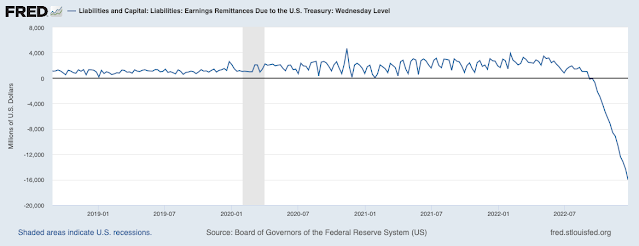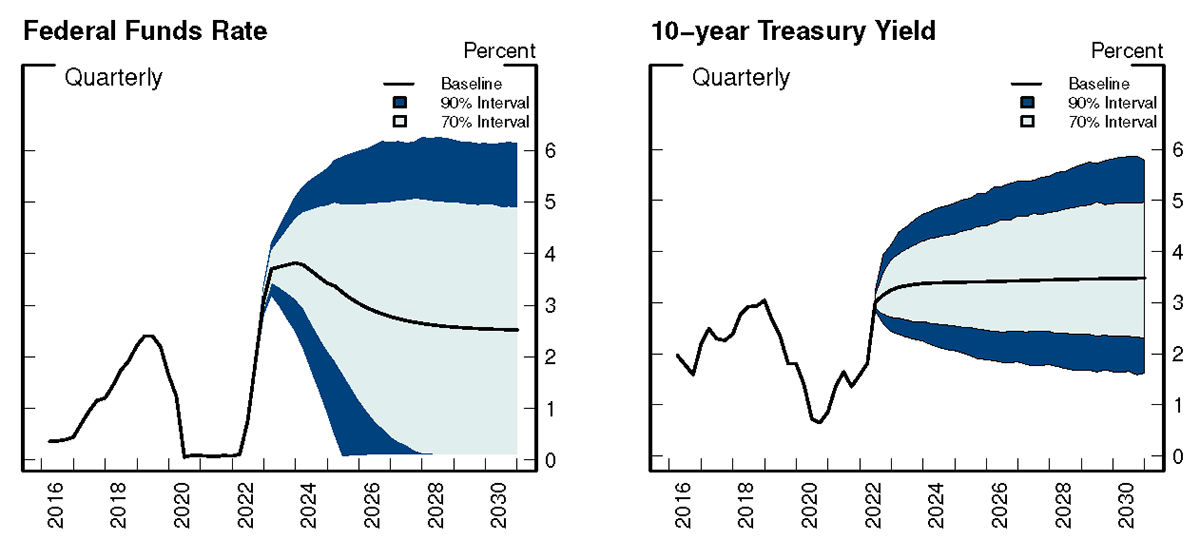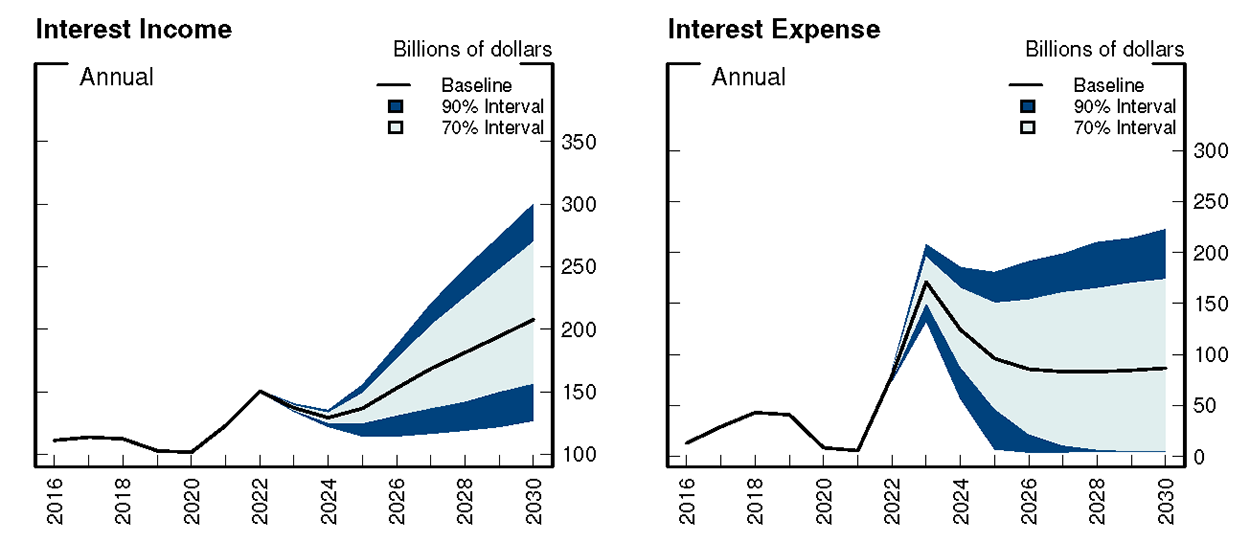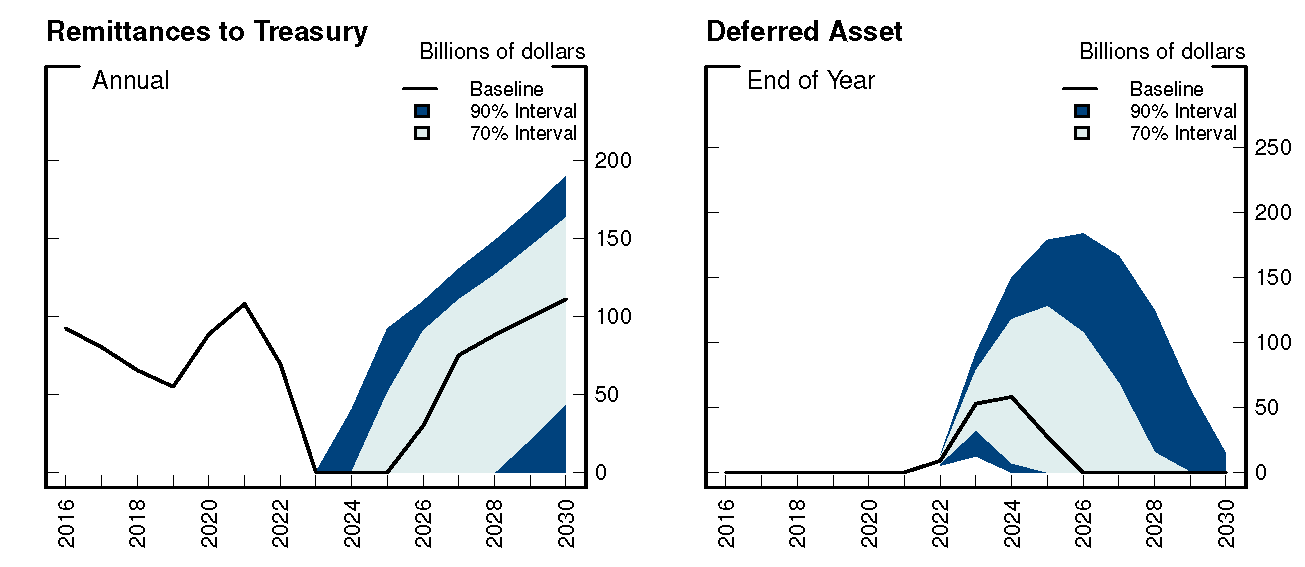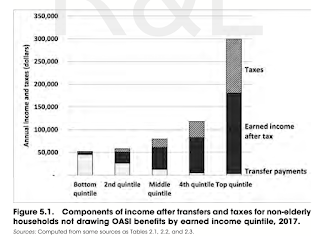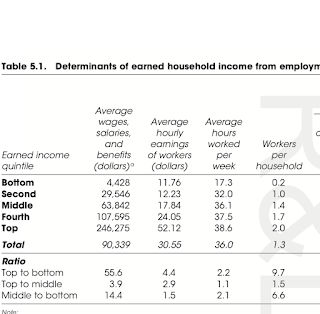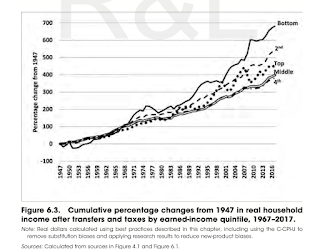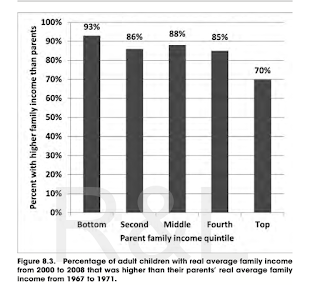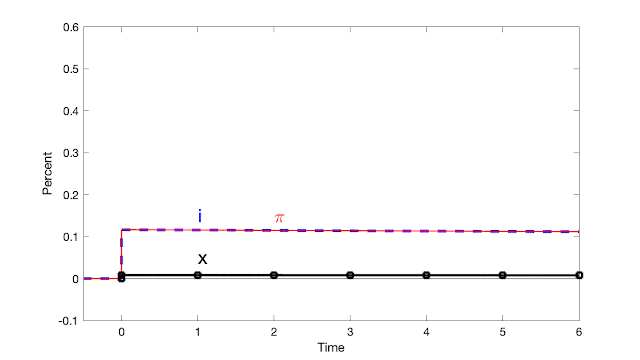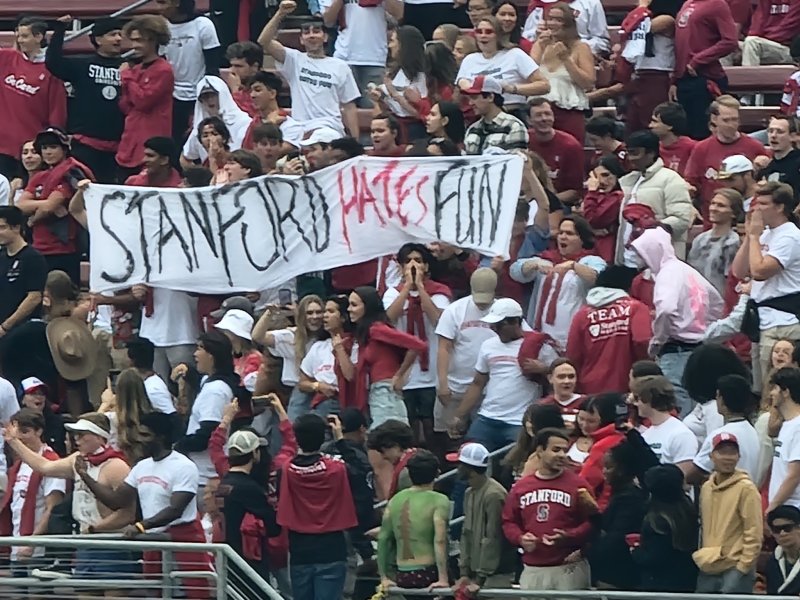 |
| Source: Stanford Daily |
Stanford hates fun is the title of the second Stanford article in the Wall Street Journal this week. (On the first, Stanford's guide to acceptable words, enough said already.)
This has been bubbling up for a while. Last June, Ginevra Davis wrote a powerful article in Palladium, "Stanford's war on social life." She recounted how the slightly transgressive Stanford atmosphere in the 90s, which seeded the slightly transgressive get it done attitude of tech in the early 2000s, is being smothered by the Administration. For example, back in the early 90s,
...The brothers were winding down from Kappa Alpha’s annual Cabo-themed party on the house lawn.... a day-to-night extravaganza that would start sometime in the morning and continue long after midnight. The girls wore bikini tops and plastic flower leis, and the boys wore their best Hawaiian shirts.
Uh-oh, I can already smell trouble if you tried that today. But the point,
That year, the brothers had filled the entire main level of Kappa Alpha’s house with a layer of sand six inches deep. The night was almost over; the guests were leaving and the local surf rock band had been paid their customary hundred dollars in beer. The only question was what to do with all the sand.
No one remembers who had the idea to build the island. A group of five or six brothers managed the project. One rented a bulldozer...
Later that year, the brothers installed a zipline from the roof of their house to the center of the island. They also built a barge, which they would paddle around the lake on weekends and between classes.
More generally
Through the late 1990s, Stanford ... featured a wacky campus culture that combined collegiate prep with West Coast laissez-faire. Stanford was home to a rich patchwork of wild and experimental campus life. Communal living houses (“co-ops”) encouraged casual nudity, while fraternities threw a raucous annual “Greek Week” and lit their houses on fire. Until 2013, Stanford hosted a fully student-run anarchist house, where residents covered the walls with eccentric murals.
Today,
The Kappa Alpha boys have been kicked out of their old house. Lake Lagunita was closed to student activities in 2001,...
...In less than a decade, Stanford’s administration eviscerated a hundred years of undergraduate culture and social groups. They ended decades-old traditions. They drove student groups out of their houses. They scraped names off buildings. They went after long-established hubs of student life, like fraternities and cultural theme houses...
A powerful observation: This spirit of self-organization, slightly transgressive but organized fun taught students how to organize things like the 2000s tech revolution.
Stanford’s support for the unconventional pioneered a new breed of elite student: the charismatic builder who excelled at “breaking things” in nearby Silicon Valley.
... unlike most elite schools, ...Stanford ... was also fun. Stanford had created a global talent hub combined with explicit permission for rule-breaking. As a result, students learned a valuable lesson: they had agency; they could create their own norms and culture instead of relying on higher authorities.
Young kids need to be out in the playground negotiating the rules themselves, without lots of parents and coaches around. College students need self-organized parties and pranks to learn to be tech entrepreneurs. I had always disparaged "party schools" as places with too much drinking and not enough studying, and most parties seem to me like a pointless drunken bacchanalia. But the importance of self-organized activity is something I had missed.
The article explains nicely the advantages of fraternities and sororities to young people.
In the middle of my freshman year, I started noticing that students, particularly older ones not in a housed Greek organization, seemed quite aimless and very lonely....
When students live together, united by a shared identity, they tend to look after each other. The boys in one fraternity sleep together in a pile on the floor. Girls in housed sororities leave their doors open and treat their clothes like a communal wardrobe.
The process
In 2013, the administration took over the student-run anarchist house and painted over the old murals. The next year, Stanford drained the remnants of Lake Lagunita, where students used to gather to host bonfires, and ended the annual anything-but-clothes party known as Exotic Erotic. And the year after that, in 2015, the administration put the notoriously anti-establishment Leland Stanford Junior University Marching Band on “super-probation,” the culmination of years of increasing restrictions on their antics.
over the ensuing years, the Band mostly lost its raucous, fraternity-esque culture, and stopped doing anything particularly controversial. Once, the Band mocked Stanford’s rivals with crass marching formations; today, the Band designs all their pranks based on pre-approved themes from the university and clears the final plans with a panel of administrators.
Then they came for the fraternities
One night, I was biking home late from the Caltrain. I made it halfway back to my dorm before I realized that something was missing. Music. It was a Friday night, but the campus was completely silent.
Unlike Harvard, which abruptly tried to ban “single-gender social organizations” and was immediately sued by alumni, Stanford picked off the Greek life organizations one by one to avoid student or alumni pushback. The playbook was always the same. Some incident would spark an investigation, and the administration would insist that the offending organization had lost its right to remain on campus. The group would be promptly removed.
...When Stanford could not remove a student organization for bad behavior, they found other justifications. One such case was the end of Outdoor House, an innocuous haven on the far side of campus for students who liked hiking. The official explanation from Stanford for eliminating the house was that the Outdoor theme “fell short of diversity, equity and inclusion expectations.” ...
Next year, Outdoor House will be reinstated, but only because house members promised to refocus their theme on “racial and environmental justice in the outdoors.” Upholding diversity, equity, and inclusion is the first of four “ResX principles” that now govern undergraduate housing. Stanford reserves the right to unhouse any organization that does not, in their opinion, uphold these principles.
Covid provided the excuse to really clamp down. The new system sounds awfully bleak.
The first thing Stanford announced was the introduction of a new housing system, designed to promote “fairness” and “community” on campus. Under the system, new freshmen would be assigned to one of eight artificially-created housing groups called “neighborhoods,” each containing a representative sample of campus housing.
The reality of the neighborhood system is that it strips students of their ability to form distinct personalities or formal friend groups. I am in Neighborhood S. Some of my friends are in Neighborhood N. It doesn’t actually matter. The neighborhoods are not based on geography—many houses in the same “neighborhood” are on opposite sides of campus—and have no personalities outside of their letter name. They are distinctions without meaning.
... students in “bad housing”—the labyrinth of themeless, meaningless dorms awaiting most Stanford students—rarely bother to learn their neighbor’s names. Hallways are quiet and doors are locked. Without a strong existing support network, these students can easily bounce from anonymous dorms, to lecture halls, to cavernous dining halls without anyone acknowledging their presence for days.
..Stanford students live in brand new buildings with white walls. We have a $20 million dollar meditation center that nobody uses. But students didn’t ask for any of that. We just wanted a dirty house with friends.
When I tell current Stanford students the story about JP and his island, I swear their eyes pop out of their heads. Everything was so different then. It sounds like a story from another school—the house, the lake, and the groundskeeper who let the boys pass. But mostly, what feels foreign is the spirit expressed by the six brothers, the wild unfettered joy.
A bottom line
Stanford’s new social order offers a peek into the bureaucrat’s vision for America. It is a world without risk, genuine difference, or the kind of group connection that makes teenage boys want to rent bulldozers and build islands..
***
Izzy Meyerson followed up in the Stanford Daily. Izzy transferred from the University of Chicago,
...the place where “fun goes to die.” Yet, in my first quarter at Stanford, I found myself missing the unique community hubs that so easily brought people together at the University of Chicago: the student run coffee shops, each with its own personality (the one for indie kids, the one for econ bros and their adjacents, the one for more edgy, subversive “alt” students, etc…), the student center, even the silent Harper Library, which was a place for me to hang with friends and meet new people...
When I was at UChicago, there was an active effort underway to make the school more appealing to the general high achieving high school student... This involved embracing looser restrictions ... and a new community-driven student life strategy. It seems to me that Stanford is heading in the opposite direction, embracing the “where fun goes to die” mantra that UChicago is trying so hard to shed.
...when I arrived at Stanford in the fall of 2021, I saw a dull and tired campus, one that had forgotten it was supposed to be the fun California school... I spent much of my time working in my room, and I am someone that hates working in my room. But there were few social places to work on campus where you could meet new people. I felt awkward and unwelcome when I walked into the first floor of Green to absolute silence and stares from people as the squeak of my shoes seemed to fill the emptiness of the space.
Izzy has a deep point. The lack of campus social life is about a lot more than big alcohol-fueled parties.
...Stanford has been eroding away traditions (such as Full Moon on the Quad) and historical community hubs through the Neighborhood System. This was easy for them to do — there was an entire year of remote schooling in which traditions were not passed down to the incoming class, and so their demise was imminent. Though such traditions may seem frivolous, it is exactly these small, uniquely Stanford events that bring people together...
..what makes college so valuable is the relationships you make with others across wide and varying backgrounds.... But we must have access to abundant social interactions and involvements for such meaningful growth to take place. So, I implore you, Stanford, to embrace “fun” again, revitalize our unique campus culture, not simply for the enjoyment of the student body but to allow your students to build themselves into complex and diverse beings.
The WSJ notes
Stanford began mandating students file an application two weeks ahead of a party including a list of attendees, along with sober monitors, students said.
The number of registered parties dwindled to 45 during the first four weeks of school this fall, down from 158 over the same period in 2019, according to the Stanford Daily.
My jaw dropped. Filing an application for a party two weeks ahead of time? Deciding what party you're going to go to two weeks ahead of time? You must be kidding. I went to MIT, lived in a dorm, and even there parties were organized about 5 minutes ahead of time! "List of attendees?" Is this China? The university keeps track of who is invited to what party?
What's going on? It's right there -- "Upholding diversity, equity, and inclusion is the first of four “ResX principles” that now govern undergraduate housing.." " Stanford announced was the introduction of a new housing system, designed to promote “fairness”.." The bureaucrat's vision of "Diversity, Equity and Inclusion" cannot stand any self-organization by students. Voluntary association might not be sufficiently "diverse" and "inclusive" (except, of course, the "affinity" groups which are deliberately not diverse and inclusive.) The only way to be "equitably" "included," apparently, is to be equally, intensely, lonely and miserable. So even the most minor social organization, like having a party, must be policed by bureaucrats. And smothered in the process.
No wonder there is a mental health crisis! Living all alone in a faceless dorm with closed doors would drive any 18 year old nuts. I found my first years in a college dorm intensely difficult, and only the fellowship of the irreverent Burton Third Bombers got me through. (Thank you all!) I can't imagine living all alone in a motel-like silent dorm a thousand miles from home. I would have cracked too.
***
Stanford's response, per WSJ, could be written by The Onion,
Samuel Santos Jr., associate vice provost of inclusion, community and integrative learning within the Division of Student Affairs, says the school is working to address students’ concerns about Stanford’s social atmosphere.
The party-planning process will be streamlined and more administrators will be hired to help facilitate student social life.
“We want events to be fun, inclusive and safe and those things can happen,” Mr. Santos says. “They just require collaboration and honesty.”
Maybe the problem is reflected in the fact that Stanford has an "associate vice provost of inclusion, community and integrative learning" in the first place! Streamlining the paperwork to ask mommy for permission to have a party is not the answer. And "more administrators will be hired !" Jaw drops again. Isn't it breathtakingly obvious that the problem is too many administrators in the first place?
***
This may seem minor. Who cares if undergraduates have fun? Well, maybe some people care if undergraduates mature into confident people, capable of organizing a party without guidance and permission from the Ministry of Parties, before they head out into the world to start the next generation of tech companies. Or, more likely take jobs as deputy directors of "inclusion, community and integrative learning" at the newly sclerotic old tech companies.
I hope, however, that Stanford's alumni will wake up and take notice. They are a key constituency for an institution that lives off their generous donations. The loss of academic freedom and free speech doesn't seem to bother them much, even when taken to the ridiculous such as the guide to acceptable words. The imposition of far-left politics under the "IDEAL" banner hasn't woken them up.
But they give money in memory of the great time they had as undergraduates -- and the experiences that made their lifelong friends, molded their personalities, and were core foundations of their current success and personal happiness. Perhaps news that these core fond memories have gone up in smoke will catalyze them.
Or, perhaps, universities are now more searching for a few billion dollar donors rather than regular checks from loyal alumni. $1.6 billion = 16,000,000 $100 checks. Inescapable math. But such donors want more public and political causes.
***
Update:
Thanks for many comments and emails.
I feel for the administrators, really. What do you do if you are provost and a big frat party has gotten out of hand? Well, the big university disciplinary machinery steps in and write rules of engagement for the drunken bacchanalia. In the face of the title 9 and DEI bureaucrats, and their kangaroo-court procedures, this ends inevitably exactly where we are.
I think the answer lies crucially here: Nothing. The price of self-organization is responsibility. Call the cops. If the frat gets sued, the frat gets sued. Rewrite the ground lease so that the frat is an independent organization. By having rules and disciplinary procedures, the university also protects the frat from its full responsibility. Maybe not, but somehow, the university has to separate itself from detailed frat management.



